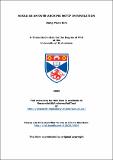Νικάω as an over-arching motif in Revelation
Abstract
This study has attempted to show the overarching significance of the conquering motif in relation to discourse dynamics of the entire book of Revelation and the significance of salvific history for its syntagmatic understanding. Based on language-in-use as a whole between the model author and the model audience, syntagmatic analysis (i.e., SVU analysis) and associative analysis (i.e., sign-intertextual reading) are eclectically and concertedly utilized by means of sampling analysis. Utilizing this integrative method, the findings are as follows: (1) the interwoven network of the prologue (Rev 1:1-8) programmatically provides the paradigmatic reading strategy for understanding the key paraenetic motif in the rest of the book against the background of salvific history; (2) by summarizing the churches’ earthly prophetic roles – withdrawal and witness through martyrdom – in terms of conquering, the model author alerts his audience to the military significance of their daily actions or choices in their ordinary earthly lives through visionary communication; (3) just as the prologue preliminarily guides, the ever-forward-moving historical framework serves as an incentive device for the paraenetic-imperative in Rev 2-3 and 4-22.
Type
Thesis, PhD Doctor of Philosophy
Collections
Description of related resources
Aland, K. et al. (eds.) 1993 Novum Testamentum Graece, 27th ed. (Stuttgart: Deutsche Biblelgesellschaft Stuttgart).Longacre, R. E. 1996 The Grammar of Discourse, 2nd ed., Topics in Lanuage and Linguistics (New York and London: Plenum Press).
Bauckham, R. J. 1993 The Climax of Prophecy (Edinburgh: T & T Clark).
Items in the St Andrews Research Repository are protected by copyright, with all rights reserved, unless otherwise indicated.

